Today we proved to ourselves that we really can get ready quickly. We slept in and didn’t get out of bed until five past 8 am. This would have been fine except we were planning on being on a 9 o’clock train. But don’t worry, we’re speedy! We were at the station, completely ready for the day, with time to spare…and we even sat and had a leisurely breakfast!
We took the train into Mainz so we could catch the boat down the Rhine. It was a good plan, except we had some faulty info and the boat wasn’t actually running. It seems there is only a ferry out of Mainz on Fridays in the fall. But we are not discouraged by bumps in the road! We walked ourselves over to the train station and hopped on a train up the river. We got off at St. Goar, which is where we were planning on disembarking from the boat.
St. Goar is a classic Rhine town, we know because Rick Seves told us so. It is full of riverside parks, half-timbered buildings and strolling sightseers. But the thing that makes it really “Rhinesque” is the hulking castle looming over it from the above hilltop. Built in 1245, Burg Rheinfels (burg being German for castle) was once the biggest on the Rhine. It withstood the French troops once in 1692, when 28,000 men attempted to capture it, but could not repeat history in 1797 when it was destroyed by the French Revolutionary Army. Why were the French over in Germany tearing down castles? Hold on to that question; we’ll get to it later! Now Rheinfels is only a fraction of it’s former self, but provides an awesome climb-about-where-ever-you-like fortress ruins experience. We took the cute little trolley up to the castle. It was cheap and there and about to leave as we walked up, so we just hopped on. When we entered the fortress we were provided with a self-guided tour map. We are thankful for this as we wouldn’t have had any idea where to start otherwise. We saw the sight of the battlements, the prison and the slaughterhouse, as well as many other castle essentials. The tour took you both up on the walls & the towers and into the old rooms and underground passages. The best part though might have been just taking in the ruin aspect. There are these huge, thick stone walls that have partially crumbled and been removed for building stone by the people of St. Goar below. And over it has grown grass and vines and other greenery that makes it look so much older and more awe-inspiring. Here’s a few photos to get the idea across:
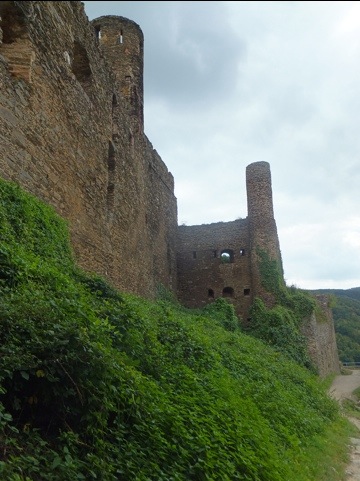
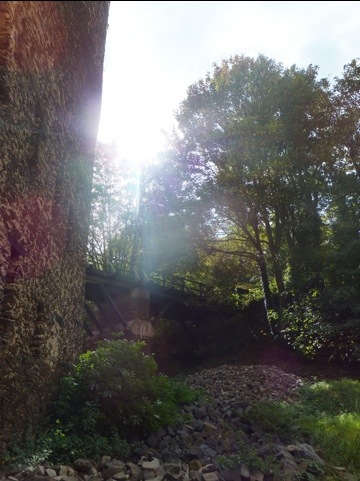
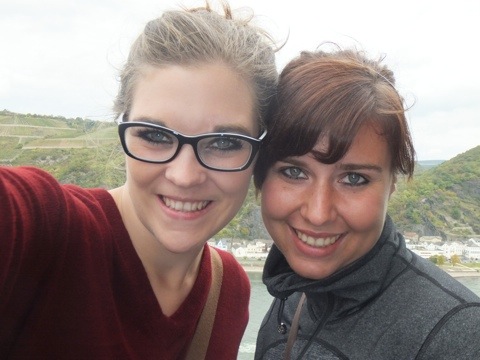
When we finished exploring the hidden corners of the past, we hiked down the hill and into town. There’s not much to St. Goar, but it did have more than one fancy Italian ice cream shop. We treated ourselves to a lunchtime snack that was not exactly part of a well-balanced diet…it was a Tropical Fruit Ice Cream Concoction (that’s what we’re calling it since we don’t have our German translations perfected yet)…
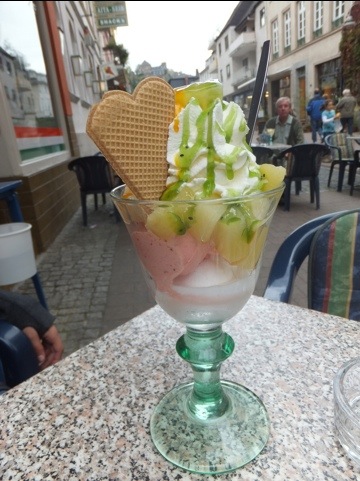
Back by the river we were able to board the KD Rhine Ferry. We had to go with this company specifically (there are 3 companies that run boats over this stretch of river) because they are the ones who let you ride free with your Eurail pass! Yay! Awesome free stuff! So in the end, it was all fine that we couldn’t catch the boat this morning; instead we rode the same stretch in reverse in the afternoon. Riding in reverse did mean that we travelled a bit slower though. The Rhine runs north from Switzerland to Holland and then the North Sea. In this area that means it runs north from Mainz towards St. Goar and then Köln.
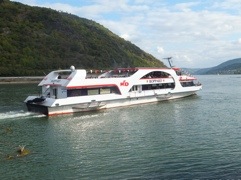
We parked ourselves at a table on the left side of the top deck. This is where Rick Steves tells you to sit for his Self-Guided Rhine Blitz by Boat! Oh Rick Steves, you are amazing! There are handy kilometer markers all along the river. The Rick Steves tour tells you what important sights you will see, something about them and what km they’re at. At one time, the Rhine was the northern boundary of the Roman empire and therefore was an important trade route. Today it continues that tradition by being the world’s busiest river, having over 300 boats travel it each day. Now to understand why the river is lined with so many castles you first must know that medieval Germany was broken up into 300 tiny independent countries. Each of these had their own petty little ruler who wanted to protect his land and make himself enough money to invade his neighbors. The countries that bordered the Rhine presented a great money making opportunity. If you could stop every ship that comes down one of the worlds most important shipping routes and make them pay a toll to pass through your land, you could make a mint! So each ruler made himself a castle and ran a long chain across the water to stop the boats. These men became known as “robber-barons”.
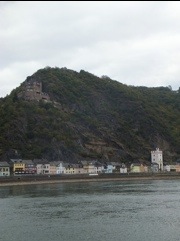
That castle there can be found at km 546 and is called Gutenfels Castle.
Throughout history the French & Germans have had a rocky relationship. Whenever the French had a strong military and a chance to visit they would come over to the Rhine, which lays almost like a border between the countries, and destroy the castles that lay along it. These appeared too storng and threatening for the French and they preferred that the castles be destroyed before they coud be used as strongholds or gathering places for troops. Burg Katz is one of such castles. Napoleon seized the chance to blow a portion of it up in 1806. It was rebuilt in 1900 in a slightly more romantic fashion. It’s now owned by a Japanese billionaire who wanted to turn it into a hotel for Japanese tourists…however his building plans were rejected so it now just sits there, empty & unused. It’s a shame…we’d live there with it as is!
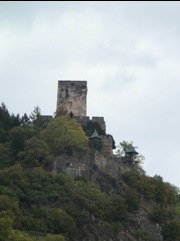
The narrowest & deepest part of the Rhine passes by a 450 ft cliff called the Loreley. Here we saw the statue of Loreley, the beautiful but deadly nymph. Legend tells how this young siren distracted a young man which led to his drowning when his ship wrecked upon the neaby reefs. When soldiers were sent to kill or capture the nymph, they cornered her in a cave where she called called upon her father (Father Rhine) for help. Huge waves rose from the river and carried her to safety, and she’s never been seen since.
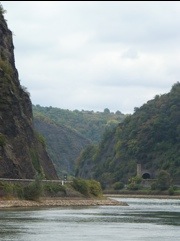
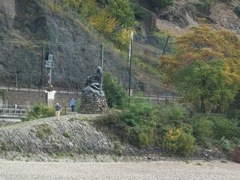
We found land at Bacharach…well we could see land the whole time, on both sides, but that’s where our feet clambered back onto solid soil. Bacharach was once prosperous from it’s wine and wood trade. Facing hardships following the 30 Years War, this town has become a perfectly preserved tourist trap. We followed a self-guided Rick Steves tour through the picturesque town. Our tour started in a nice park from 1910 that was laid out in the English style. The trees were purposefully planted to frame wonderful town views! Crossing the park we ended up in town. This is a good 60-70 ft from the river but has flood lines marking worst river-overflow years. Look at how much the river flooded in 1988!
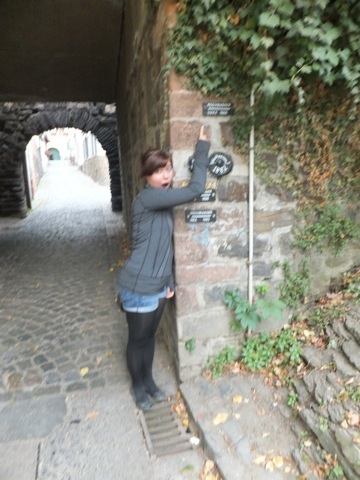
Throughout the town we found numerous little wells. Up until 1900 these 40 wells provided water to the townsfolk. Also were 6 of the original city towers surviving for us to see. These used to be the entrances/exits and the lookouts for the fortified town walls. Bacharach is full of adorable little half-timber houses. And the Rhine style is to have designs with the timbers, so they looked extra fancy & cute. The oldest one of these buildings was built in 1368 and is still standing.
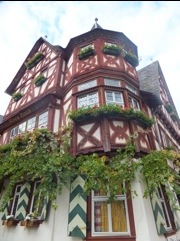
Up on the hill is Stahleck Castle. This castle is from the 13th century and is now a hostel. We weren’t able to get beds at this hostel when we got round to making our bookings. But once we got here we realized that may have been a good thing! While it would have been awesome to stay in a castle, we can’t imagine carrying our bags on the hike up to it!
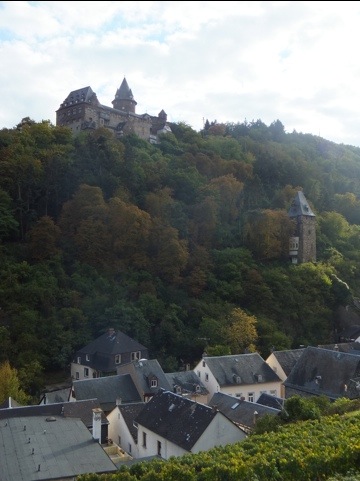
As it was we did a small hike up to one of the old watch towers on the hill. It afforded the panorama view that allowed that last picture…and many more. The walk down took us through a grape terrace. There were still grapes on the vine so we had a taste. They were very sweet…and according to a nearby sign have a future as a Rhine Valley Reisling.
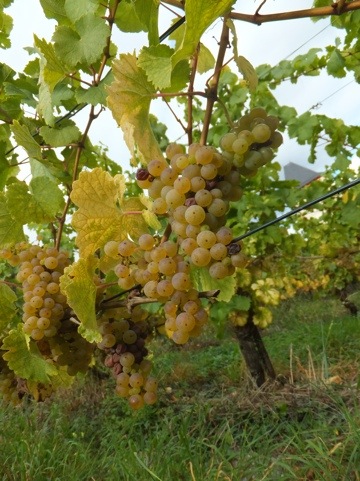
We found a small, local place for supper. We settled on a table inside as it was a little chillier today and perused the menu of schnitzels. We both got a Jägerschnitzel. The meal ended up being a 3 course affair. First came the soup…then the salad…then the schnitzel & fries…
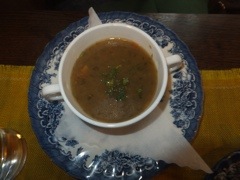
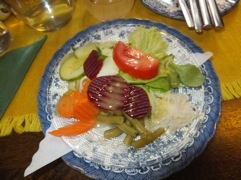
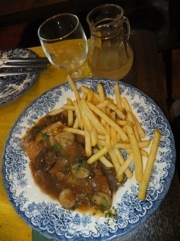
The waitress, who we are pretty sure was also the owner, convinced us to get a little jug of Lambrusco to have with our food. Lambrusco is wine that isn’t quite wine yet. It tasted like wine, but sweeter. Yum! Yum!
We are going to close with something we haven’t done in awhile: Reader Challenge! Today has left us with castles on the brain, so here’s today’s question:
If you could have a castle of your very own, where would you build it & what would it be like?
To help you out on figuring out how to answer this, we thought we could give you our answers right off the bat…
Justine:
Hidden away on one of the San Juan islands, just off the coast of Vancouver, Victoria and Seattle you will find my castle. Tucked amongst the tall and dense forest you will be able to see the many turrets and towers of my dream castle. The castle will be white with blue and purple accents, think Disney castle. My favorite room will be in one of the towers, here will be able to perch in a window seat and look out over the ocean. I don’t want my castle to take away from the natural beauty of the location and have people be like “wow that’s an awesome castle!” therefore only the tops of some of the towers will peak through the trees. From the main dock of my island there will be a lantern lit path to the front gate of the castle. There will be many sandy beaches on the island but there will also be lots of rocks and regions full of tide pools. On the far side of the island, amongst the tide pools you will find my escape home, my little Tudor cottage. Here I can play amongst the marine critters and relax by the fireplace of my cottage.
Kristin:
I would want to live in a medieval fortress. To me, when you look up at a castle, you need to feel you’ve stepped back in time…and possible arrived in Camelot. It would rise as a hulking mass of grey stone, with flat-topped, circular towers and only one large, central turret. The walls would be thick and vine-covered, but inside there would be all of the amenities of modern life. Behind would lay a large green courtyard. It would be an area reminiscent of the arenas of jousting & sword play, although for me it would be used more for reading, picnic and tossing the occasional frisbee. The whole complex would be encircled with a fortified stone wall. Each corner would feature a tall battlement and running the perimeter of the top would be wooden ramparts that I could stroll along. And a key feature of any fortress is it’s placement: it must be situated at the top of a large hill or cliff where everyone can look up and marvel at it’s intimidating beauty. My hill would have a rocky top that would quickly develop into thick forest. A single road and a set of wooden stairs would descend down to a coastal beach. But this will not be a suntan & beach volleyball type beach. It will be a forest lined, rocky outcrops, driftwood scattered, take a walk in my windbreaker beach…leaving me thinking the Oregon coast would do nicely for a location.
Love, Luck & Lots of Castles,
K&J
